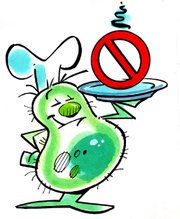Holy guacamole! Cilantro is the suspect in the latest bout of people getting sick from something they ate.
The herb is a common sprinkle of green in all sorts of Mexican and Tex-Mex cooking, such as avocado dip. The federal Food and Drug Administration has banned imports of the parsley-like plant from the Mexican state of Puebla, the suspected source of contamination.
And hold the turkey bacon: The Kraft Heinz Food Co. has recalled 2 million pounds due to possible spoilage before the due date. Texas-based Blue Bell ice cream is back in some stores, but not yet returned to Arkansas after a bacteria contamination shut down production.
Last summer, the concern was peaches and other fruits that were shipped across country from one place in California. Before that: spinach from California.
Odds are, the bad bugs are somewhere else, not on the plate in front of you. Still, the federal Centers for Disease Control and Prevention counts more than 250 ways to get sick from bacteria, viruses and parasites in food and drink, and millions of people do every year.
Each year, about 50 million Americans take a bite of digestive bad luck. Of those, about 128,000 wind up in the hospital, and 3,000 die of food-related diseases, according to the CDC.
Such dinner talk used to be even less appetizing. Cholera, tuberculosis and typhoid fever were among the most common risks of food contamination a century ago. Science has scraped those diseases off the plate, for the most part. Pasteurized dairy goods, clean water and -- no offense to Granny's wonderful peaches in a jar -- better canning made a difference.
But new infections add constantly to the menu board of miseries. Out of seemingly nowhere, for example, a new strain of bacteria (the especially gak!-sounding vibrio parahaemolyticus) turned up in the oyster beds of Galveston Bay in 1998, according to the CDC. Great as they are with a spritz of lemon juice and hot sauce, raw oysters sometimes go down with a gulp of doubt.
The agency figures about one out of six Americans chews into one bad thing or another each year.
So far this year, Arkansans have bellied up mostly to campylobacteriosis, 281 cases; and salmonellosis, 425 cases; according to the Arkansas Department of Health. (Raw meat is a likely source of these bacteria, the reason for careful handling of those Southern favorites, chicken and frog legs.)
Health workers depend on people to report when and where they got sick, and how they felt -- generally, yuck -- as clues to help find the source of contamination. Knowing the source is important to stop the illness from spreading.
SPEAK UP
"We want people to report," state epidemiologist Dr. Dirk Haselow says. Regarding the possibility of a food infection, "we are happy to receive reports on just about anything."
One way to squawk about a chicken dinner that didn't set right is through the state Health Department website at healthy.arkansas.gov. The site provides a form to fill out, and that form requires no medical know-how.
A single report can point to a restaurant that needs cleaning up, Haselow says, and it might help in the hunt for where on earth a particular bug is hiding.
"Food preservation and refrigeration -- the whole food system -- has never been safer than now," he says. But when a bug gets loose, the problem is "bigger than ever."
Back when Old MacDonald had a farm, "you were unlikely to eat anything that was grown or made more than 50 miles from home," Haselow says.
"Now, it's very unlikely for you to go a week without eating food from a different country," he says. Wide distribution of a tainted food can produce multistate clusters of disease.
The nasty possibility keeps state, federal and international health agencies on the watch for signs of trouble. To stop a bug from spreading takes world-class detective work.
The culprit on the run is a germ, after all -- a microbe invisible on the plate -- and people grab a bite without thinking, "What if?"
SUFFERING IN SILENCE
Health authorities think that most people who get sick after eating out don't report anything -- not about the usual type of "foodborne illness," as health professionals say, or what the rest of us call "food poisoning."
Some of these illnesses can be severe and even fatal, but most aren't. Most produce such mild effects that plenty of water and a few doses of an over-the-counter stomach medicine, the pink stuff, settle affairs. Bacteria, virus, parasite, toxin: Whatever bit of micro-nastiness went down the hatch, it causes an embarrassing fit of digestive upset. But it goes away, and who wants to talk about it?
Who knows where exactly the bug came from, anyway? It might have climbed aboard from a restaurant meal or a home kitchen counter that somebody forgot to wipe clean. Lacking medical diagnosis, for all you know it might have been the same gunk that's been going around the office, nothing to do with food.
When in doubt about a possibly food-related illness, Haselow recommends, let the Health Department decide what to make of it.
HARD TO SWALLOW
General symptoms include, sometimes, fever and muscle aches, nausea and every other reason for a gallop to the bathroom; but the specifics vary by bug.
• The current outbreak traced to cilantro comes from a single-celled parasite that causes cyclosporiasis, an intestinal infection.
About 500 people in 30 states have come down with the ailment, including three cases in Arkansas, according to the CDC. Cyclosporiasis causes diarrhea.
Basically, the trouble starts with a lack of cleanliness where the produce is grown, such as sewage in the irrigation water, or dirty hands and equipment where the crop is picked or shipped.
Such a lapse is rare in today's food market, and experts agree the benefits of eating produce outweigh the risks of foodborne illness. The CDC's advice is that consumers should "continue to enjoy the health benefits of eating fresh fruits and vegetables."
• Salmonellosis is one of the state's and nation's most common food-related illnesses -- nationally, 2 million to 4 million cases a year.
The bug is a bacterium that brings on, at worst, a typhoid-like fever along with intense stomach distress; in mild cases, the bug causes a few days' discomfort, according to the FDA.
• Listeriosis was the risk behind last summer's fruit recall. The bacteria, listeria, can be deadly to older people, newborns and pregnant women. The FDA rule is zero tolerance for listeria contamination. The fruit involved in the recall might have passed inspection elsewhere, but not here.
VISIT THE LITTLE ROOM
Confirmed cases of foodborne-illness come from medical diagnosis, typically based on a stool sample.
Doctors who confirm a food-related infection are required to report it to the Health Department, Haselow notes.
People who merely suspect their midnight miseries came from the rank chili at Joe's Chew-and-Choke can rest assured that the department's bug-report form will lead them through a series of questions.
"It's pretty unlikely it came from the last meal you ate," Haselow says. "More likely, it came from the meal you ate two days ago."
That people don't remember what they had for dinner two days ago makes it harder to compile this sort of record, the doctor says.
Some illnesses take days, weeks, even months to incubate. The form asks for an accounting of foods eaten -- what, where and when -- going back four days.
Other questions relate to symptoms, such as how long the upset lasted, and further queries narrow the possible ways that a person might have tasted trouble:
• Been playing with a turtle? (Turtles can carry salmonella.)
• Swimming in the river? (The water might have been dirty.)
• Has anyone else in the family been sick this same way?
• Does anybody in the family work at a restaurant?
If the answers point to Joe's chili pot, then Joe can expect a visit from a health inspector -- especially if several reports point the greasy finger at Joe's joint.
The Health Department can shut down a restaurant, Haselow says, and it happens; but most owners see every reason to run the cleanest possible business.
If the trouble came from Aunt Mildred's egg salad, fresh out of the car trunk on a hot day, well -- there's a reason some of these cases go unreported, and why some dishes at the church potluck don't get eaten, and why the warning is whispered down the buffet line: "Plague on a plate," and word gets around.
Official report of a food illness is word gotten around more effectively.
The idea, as summed up by the Health Department website, and sprinkled with safety inspection-cleared cilantro, is that reporting your food-illness suspicions "may prevent others from becoming ill."
...
Food-related illnesses can be reported to the Arkansas Department of Health online at healthy.arkansas.gov, by phone at (501) 661-2169, by mail to 4815 W. Markham St., Little Rock, Ark. 72205, or to any of the department's local health units throughout the state.
ActiveStyle on 09/07/2015




